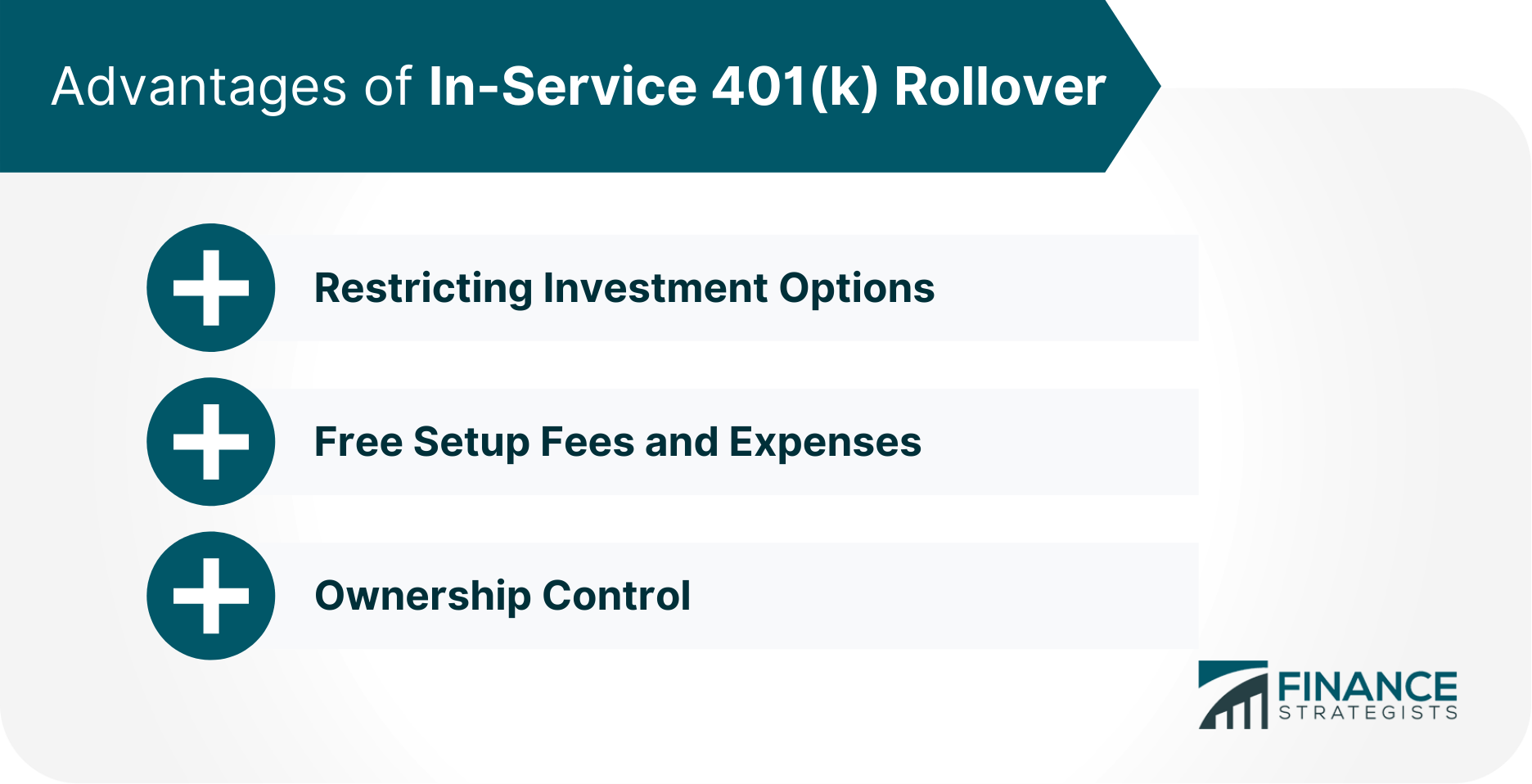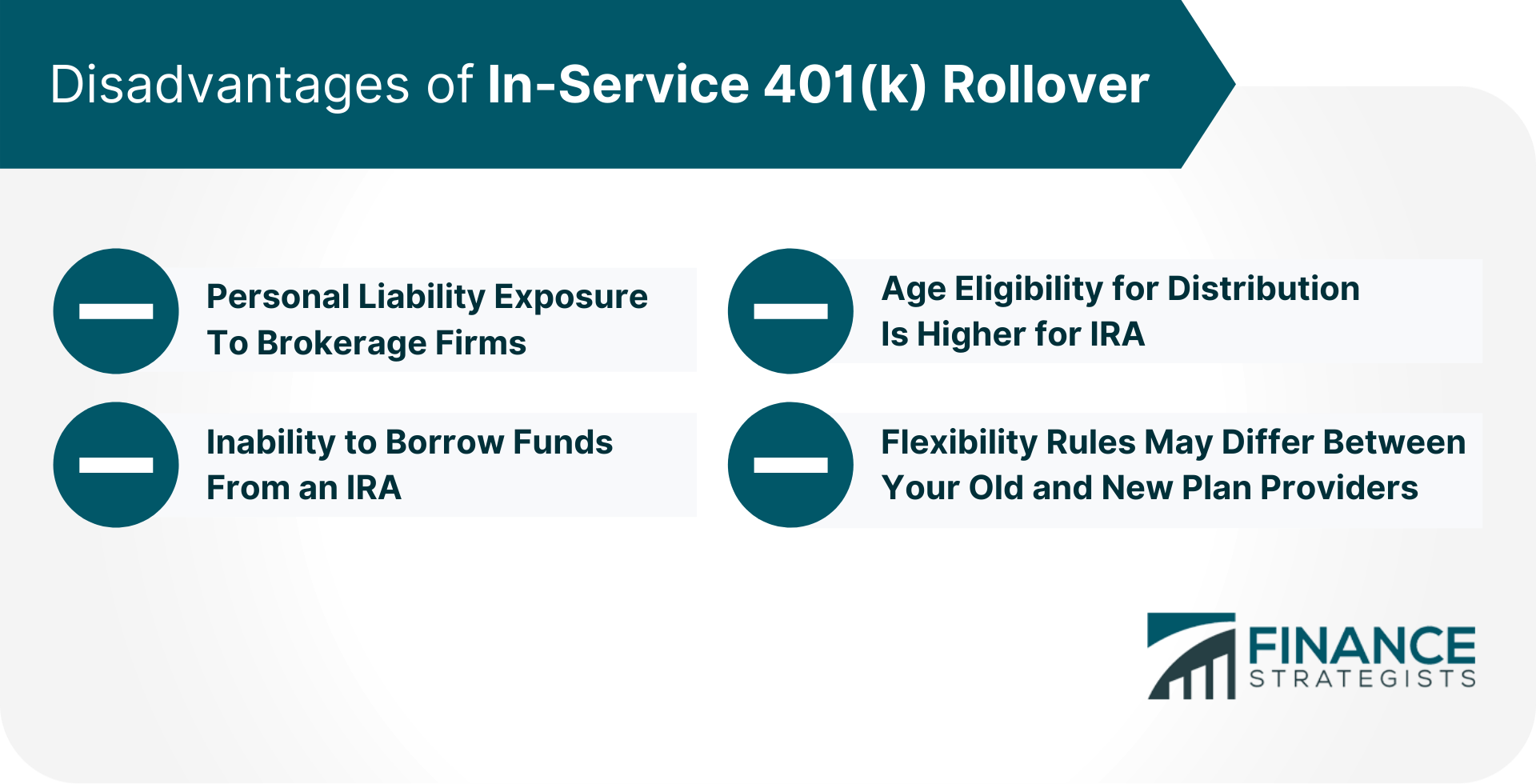In-service means "during the service". So, basically an In-Service 401(k) Rollover is a rollover option that allows current employees to roll over funds from their existing 401(k) plan into an IRA. This allows them to enjoy a wider range of investment options, including mutual funds, stocks and bonds. Have questions about 401(k) Rollovers? Click here.
In order to perform a rollover from a 401(k) account into an IRA, one needs to open an IRA with an eligible financial institution (a broker-dealer, bank or other entity that holds IRAs). You must then allocate your rolled-over funds into that IRA by making deposits or transferring the funds in your 401(k) account. The eligibility for in-service 401(k) rollover generally depends on what type of plan you hold. This is because different rules and regulations apply for each type of plan. Note that not all plan providers will allow employees to do an in-service 401(k) rollover and if others do, rules vary for each. In terms of plan life, eligibility may also differ. There are others who may allow in-service 401(k) rollover for plans that have been existent for a minimum of five years. Some may also allow it even if the plan is only two years old. In terms of plan type, eligibility may also vary. In-service 401(k) rollover may not be allowed for participants who hold a safe harbor 401(k) plan. Participants whose employer sponsors a SIMPLE IRA or a Safe Deposit Box Option may not be able to perform in-service 401(k) rollovers either. So to check on eligibility, it is best to contact your plan provider directly. The advantages of in-service 401(k) rollovers include the following: You can restrict your investments to just mutual funds or equity, allowing you to choose from a wider variety of investment choices. For example, you may be able to invest in stocks that the 401(k) plan does not offer. You can put your investments in a bond fund to shield yourself from risk and also enjoy tax-deferred growth of your gains. Some firms provide free setup fees or low expense ratios for IRAs, allowing you to have more retained earnings for your retirement savings. This is why it is important to do research before opening an IRA. When you rollover your 401(k) plan to your IRA, you will be the one in charge of investing. As compared to having a 401(k) provider do it for you under their terms, allowing you to make any changes based on market conditions and other factors. On the flip side, there are also some disadvantages that come with an in-service 401(k) rollover: Rolling over funds into an IRA could expose participants to the risk of making poor investment choices or getting involved with high-risk, high fee investments from their broker-dealer or financial institution. That way they would be more exposed to liabilities if things go wrong. Since an IRA is a type of personal retirement savings account, you cannot open one with the intention to borrow from it. Unlike 401(k) plans, which allow borrowing against the plan assets for financial emergencies or other investments prior to retirement, there is no such provision for IRAs. A 401(k) account owner may take distributions as early as age 55 following certain guidelines to enable the plan owner to be free from penalty-free withdrawal. However, for IRA, one may only withdraw funds without penalty at 59 1/2 years of age. Different rules apply when it comes to the timing of election changes between old plan providers and new ones. This means that if you decide to change your investments post-in service 401(k) rollover, you may lose out on current market conditions or suffer other losses because of transfer errors. Additionally, different plan providers may also have different withdrawal eligibility requirements which makes it hard to follow. So, in a nutshell, in-service 401(k) rollover is a good option for plan owners who want to be in control of their retirement investments and not have a third party make investment decisions for them. However, they must also consider the downsides that come with in-service 401(k) rollover because going to an IRA may not be a good fit for everyone even if it comes with more flexible rules, no administrative fees, and other advantages. Before doing anything like this, make sure you do your research and contact your current plan provider first to confirm whether or not they will allow in-service 401(k) rollover and what their rules are. So as much as possible, seek out information beforehand about what next steps you need to do for an in-service 401(k) rollover. Without a doubt, make sure you do not rush into this decision as it can have a huge impact on your retirement savings and future goals.How Does In-Service 401(k) Rollover Work?
Eligibility for In-Service 401(k) Rollover
Advantages of In-Service 401(k) Rollover

Restricting Investment Options
Free Setup Fees and Expenses
Ownership Control
Disadvantages of In-Service 401(k) Rollover

Personal Liability Exposure To Brokerage Firms
Inability to Borrow Funds From an IRA
Age Eligibility for Distribution Is Higher for IRA
Flexibility Rules May Differ Between Your Old and New Plan Providers
The Bottom Line
In-Service 401(k) Rollover FAQs
An in-service 401(k) rollover is the process of transferring your money from one retirement account to another while you are still working with your employer.
In-service 401(k) rollover is a great option to get more control over your retirement savings. Additionally, it allows you to be flexible with the market without having third-parties make investment decisions for you. However, there are also some disadvantages that come with doing an in-service 401k rollover such as personal liability exposure and not being able to borrow from your IRA account if needed.
An IRA is more flexible than a 401(k) plan in terms of investment options.
If you want to transfer your money between providers, depending on your situation, you might have some expenses or fees involved with the process. Therefore, it's important that you understand how much these costs will amount to so you can prepare yourself based on what your provider can provide.
This may be different depending on your provider and industry standards. When it comes to transferring funds between providers, the process is usually more efficient when you submit a direct transfer instead of using tools like checks and wire transfers.
True Tamplin is a published author, public speaker, CEO of UpDigital, and founder of Finance Strategists.
True is a Certified Educator in Personal Finance (CEPF®), author of The Handy Financial Ratios Guide, a member of the Society for Advancing Business Editing and Writing, contributes to his financial education site, Finance Strategists, and has spoken to various financial communities such as the CFA Institute, as well as university students like his Alma mater, Biola University, where he received a bachelor of science in business and data analytics.
To learn more about True, visit his personal website or view his author profiles on Amazon, Nasdaq and Forbes.











